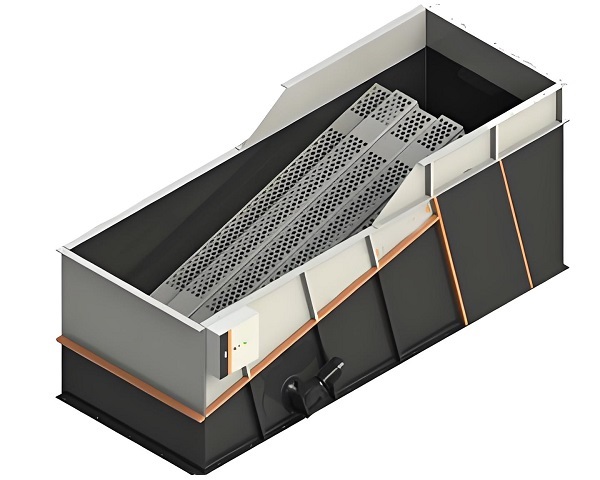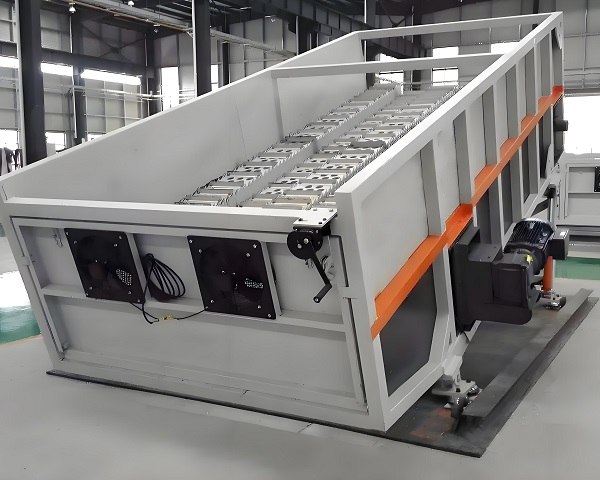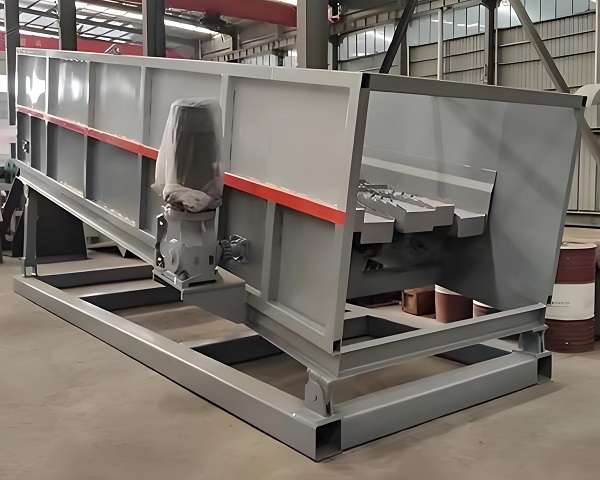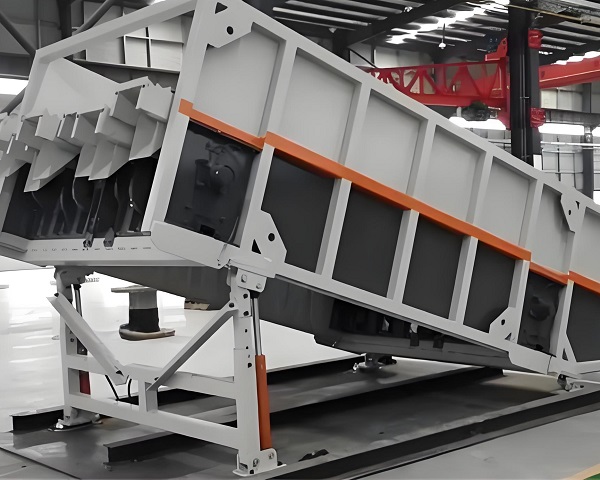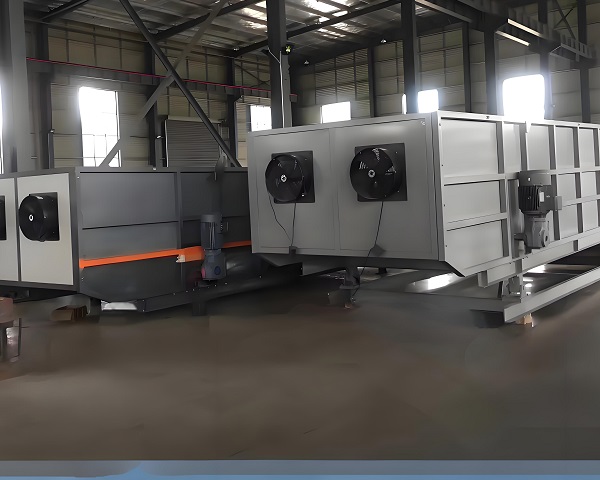A Trommel Screen is a rotary drum screening machine widely used in waste processing, mining, and construction industries. It efficiently separates materials by ......
What is the Ballistic Screen for Sale
Ballistic Screen, also known as ballistic screen, is a high-efficiency screening equipment specially used in urban solid waste sorting systems. It is widely used in the primary separation of materials such as domestic waste, packaging waste, and construction waste. The equipment mainly relies on a bouncing board with a certain angle to reciprocate and vibrate, so that materials with different physical properties can be automatically sorted according to their shape, density and bouncing performance.
The core structure of the Ballistic Screen includes multiple inclined bouncing boards that move back and forth. These slats vibrate at a specific angle and frequency, so that the materials move along different trajectories on the screen surface. Materials can usually be divided into three types: flat materials (such as paper, plastic film, etc.), which are pushed to the top outlet of the screen surface during vibration; rolling materials (such as plastic bottles, metal cans, spherical objects, etc.), which move to another outlet due to their rolling characteristics; fine materials (such as dust, glass fragments, etc.) fall into the lower collection area through the gaps between the slats.
Compared with traditional drum screens or vibrating screens, Ballistic Screen has significant advantages in processing dry, light, and diversified domestic waste. It has high sorting efficiency, low clogging rate, and can avoid problems such as plastic film entanglement. By adjusting the inclination angle of the slats and the movement frequency, it can flexibly adapt to different types of garbage and improve the intelligent sorting effect of the entire line.
The ballistic screen has a sturdy structure, easy maintenance, low operating energy consumption, and is suitable for 24-hour continuous operation. It is usually used as a pre-screening equipment in the intelligent sorting line, and is used in conjunction with wind separators, photoelectric separators, magnetic separators and other equipment to significantly improve material purity and recycling efficiency.
Ballistic Screen is an important equipment in modern solid waste resource treatment. With its reliability, adaptability and efficient sorting performance, it has become an important technical means to achieve garbage reduction, harmlessness and resource utilization. With the development of garbage classification and environmental protection industries, its application will become more and more extensive.
Operating principle of Ballistic Screen for Sale
Ballistic Screen is an advanced equipment for solid waste sorting. It mainly relies on the inclined screen plate to do periodic bouncing motion to separate mixed garbage into three categories according to the material form, particle size and movement trajectory: light materials (such as plastic film, paper, etc.), heavy materials (such as glass, metal, stone) and medium-sized screen materials (such as organic matter, fine soil, etc.). This equipment is widely used in the resource processing process of urban domestic waste, packaging waste, construction waste and industrial solid waste, and is an indispensable core equipment in modern waste sorting lines.
Its working core lies in a set of inclined moving screen plates, which are installed at a fixed angle (usually 10°\~20°) and swing back and forth at a certain frequency. This swing combined with the angled design of the screen plate will cause the material to bounce and slide on the screen surface. Due to the differences in the movement characteristics of different materials under stress, their running trajectories and distribution behaviors on the screen surface will naturally differentiate, thereby achieving effective classification.
Lightweight materials are easily bounced and thrown to the far end of the equipment due to the large impact of air resistance and low density; heavy materials usually slide to the near end due to their high inertia and density; while fine materials fall into the collection area below through the gaps or holes on the screen plate and become screen undersize. This sorting method based on the dual effects of "physical motion laws" and "particle size morphology" does not rely on compressed air or complex sensors, and has the advantages of high reliability, low energy consumption and simple maintenance.
In order to enhance the sorting effect, Ballistic Screen is usually equipped with a multi-stage screen plate and a variable frequency control system, which can adjust the vibration frequency and screen plate angle to adapt to materials of different types and humidity. At the same time, in order to improve durability, the screen plate is often made of wear-resistant alloy or reinforced plastic material, which has good corrosion resistance and impact resistance.
Ballistic Screen uses the mechanical bouncing and tilted distribution structure design to use the bouncing behavior, particle size and density differences of the material for efficient physical sorting. It is an ideal equipment for rough sorting, pre-sorting and high-quality material recycling in the current automated garbage disposal system.
Advantages and features of Ballistic Screen for Sale
Ballistic Screen, also known as a bouncing sorter or projectile screen, is a highly efficient separation device specially used in solid waste sorting systems. It is mainly based on the differences in material form, weight and movement trajectory. It separates materials into three categories: "flat/soft objects", "rolling objects/hard objects" and "fine materials" through tilted vibration plates. It is an indispensable key equipment in the sorting lines of urban domestic waste, packaging waste, construction waste, etc.
The core feature of the ballistic screen is that it uses multiple tilted screen plates (vibrating rods or bouncing plates) that vibrate back and forth at a fixed frequency to continuously throw and transport the materials forward. During the movement, the material chooses different paths according to its own characteristics: flat materials (such as plastic film and paper) will slide along the top of the screen plate; rolling materials (such as plastic bottles and metal cans) will bounce upward; small-sized fragments will fall through the screen gap to achieve efficient three-way sorting.
One of its main advantages is its compact structure and low energy consumption. Compared with high-energy-consuming equipment such as air separation and optical separation, the ballistic screen relies on mechanical vibration to achieve sorting, and does not rely on compressed air or complex electronic systems. Therefore, it is more energy-saving and reliable, and suitable for long-term continuous operation. There is almost no material blockage during the operation of the equipment, and it has extremely strong processing continuity and system stability.
The ballistic screen is insensitive to the moisture content of the material and has strong adaptability. It is especially suitable for urban mixed garbage with more water and organic matter. Its high sorting accuracy can significantly improve the processing efficiency of subsequent automated identification equipment (such as optical sorters and manual sorting tables). According to different processing volume requirements, the equipment can be configured with different numbers of vibrating screen plates and screen gap spacing, which is highly flexible and suitable for large, medium and small garbage treatment plants.
In terms of maintenance, the Ballistic Screen has a simple design, few key components, low wear, replaceable vibrating screen plates, convenient daily maintenance, long service life, and low comprehensive operating costs. Through the closed or hooded design, it can also effectively reduce dust and meet environmental emission requirements.
Ballistic Screen has become an important equipment in modern solid waste resource treatment systems due to its advantages of high efficiency, low energy consumption, high sorting accuracy, strong adaptability and easy maintenance. It is particularly suitable for use in conjunction with air separation, magnetic separation, optical separation and other technologies to improve the overall sorting efficiency and resource recovery rate.
Technical Parameter Table of Ballistic Screen for Sale
| Model | Screening Area (m²) | Number of Screening Panels | Screen Angle (°) | Particle Size Range (mm) | Capacity (t/h) | Motor Power (kW) | Machine Dimensions (mm) |
|---|---|---|---|---|---|---|---|
| BLS1200 | 4.8 | 4 | 15–25 | < 80 | 5–10 | 5.5 | 4200 × 1500 × 2200 |
| BLS1600 | 6.4 | 4 | 15–25 | < 100 | 8–15 | 7.5 | 4600 × 1800 × 2400 |
| BLS2000 | 8.0 | 5 | 15–25 | < 150 | 12–20 | 11 | 5000 × 2200 × 2600 |
| BLS2400 | 9.6 | 6 | 15–25 | < 150 | 15–25 | 15 | 5400 × 2400 × 2700 |
| BLS3000 | 12.0 | 6 | 15–25 | < 200 | 20–35 | 18.5 | 5800 × 2600 × 2800 |
| BLS3600 | 14.4 | 7 | 15–25 | < 250 | 30–50 | 22 | 6200 × 2800 × 3000 |
If you have any special requirements, we will customize according to your special needs.
Product Picture Display of Ballistic Screen for Sale
FAQ about Ballistic Screen for Sale
>What industries are ballistic screens mainly used in?
It is widely used in chemical, food, pharmaceutical, metallurgical, mining, environmental protection and other industries. In the food industry, it screens raw materials such as flour and powdered sugar; in the pharmaceutical industry, it screens drug powders; in the environmental protection industry, it screens recycled materials, etc., helping various industries to improve material processing efficiency and quality.
>What types of materials can ballistic screens handle?
It can handle mixtures, recycled paper, garbage-derived fuels, biodegradable waste, domestic solid waste, decoration waste, stale waste, large waste, etc. It is especially good at materials of different shapes and specific gravities, such as separating plastic waste from cardboard, waste paper and film.
>What are the advantages of ballistic screens over traditional screening equipment?
It has higher screening efficiency and can handle materials with complex characteristics; it has the advantage of anti-clogging, and the material is not easy to adhere to the screen; it has strong processing capacity, stable equipment operation, and relatively simple maintenance, long overall service life, and can effectively reduce the overall cost of the enterprise.
>What are the characteristics of the screen material of ballistic screen?
Stainless steel is often used, with a mature structure, strong and durable, strong wear resistance and corrosion resistance, and can adapt to the screening of various complex materials, ensuring long-term stable operation of the equipment and reducing the frequency of screen replacement.
>How to adjust the screening effect of ballistic screen?
The eccentric shaft speed can be adjusted to change the frequency and amplitude of the screen plate movement; the screen plate inclination angle can be adjusted to control the residence time and movement trajectory of the material on the screen surface; and the screen with a suitable screen size can be selected according to the material characteristics to achieve accurate screening.
>What are the daily maintenance tasks of ballistic screen?
Regularly check the operating status of key components such as eccentric shafts and motors to check whether there is looseness or wear; clean the materials adhering to the screen to ensure that the screen holes are unobstructed; lubricate the bearings and other parts to ensure smooth operation of the equipment and extend its service life.
>How to measure the processing capacity of ballistic screen?
It is usually measured by the weight or volume of materials processed per unit time. The processing capacity is affected by many factors such as equipment model, screen specifications, material characteristics, and operating parameters. Large equipment can process a large amount of materials per hour to meet large-scale production needs.
>What role does ballistic screen play in the field of environmental protection?
In urban waste treatment, it is used for preliminary screening of construction waste and decoration waste to remove large debris; in the resource recovery stage, it helps to finely screen recyclable materials such as waste plastics and metals, improve resource recovery rate, reduce the amount of landfill incineration, and reduce environmental pollution.
>Is the installation of ballistic screen complicated? Does it require a special foundation?
The installation is not complicated, but a solid foundation is required to support the vibration load of operation, generally a concrete foundation is required. During installation, ensure that the equipment is level and accurately connect each component. The manufacturer usually provides detailed installation guidance and technical support.
>What faults may occur when using ballistic screen?
There may be motor failures, such as failure to start and abnormal speed; wear and tear of the screen plate, affecting the screening effect; loosening and deformation of the eccentric shaft components, resulting in abnormal vibration; and there may also be problems such as reduced screening efficiency due to material blockage.
>What is the particle size range of materials that ballistic screen can handle?
By replacing the screen with different mesh sizes, it can process materials ranging from fine particles to larger blocks. The smallest can process particles as fine as millimeters, and the largest can handle material blocks of several centimeters or even larger sizes, with strong adaptability.
>What is the energy consumption level of the ballistic screen?
Energy consumption is related to equipment power, operating time, and material processing volume. Generally speaking, its design focuses on energy saving. By optimizing the vibration system, while ensuring efficient screening, it reasonably controls energy consumption and reduces corporate operating costs.
>What factors affect the service life of the ballistic screen?
Material properties (such as corrosiveness, hardness), frequency of use, maintenance, equipment quality, etc. Harsh materials are easy to wear equipment, frequent use increases losses, regular maintenance can extend life, and high-quality equipment is inherently more durable.


























